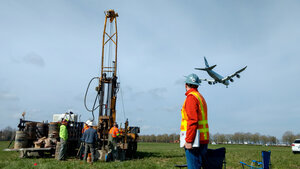
Recent subduction zone earthquakes, including the 2010 Maule, Chile and 2011 Tohoku, Japan earthquakes, have gained significant attention due to their strong intensity of shaking and long duration. The Cascadia Subduction Zone, running 1,000 km from Northern California in the south to British Columbia in the north, last ruptured on 26 January 1700 with an estimated moment magnitude of ~9.0, and produced a tsunami that resulted in thousands of deaths and casualties as far away as Japan (Atwater et al. 2004). On the basis of turbidite deposits off the Pacific Northwest coastline, Goldfinger et al. (2012) estimated that the likelihood of the next Cascadia earthquake ranges from 7 to 12% and 37 to 42% in 50 years for the northern and southern margins of the subduction zone, respectively.
The largest seismic risk to the Portland International Airport runways is soil liquefaction and settlement. Following an earthquake of significant magnitude, the ground beneath the runways is likely to settle and spread, cracking and breaking the pavement surface and rendering it unusable for airplanes. It’s critical to have an operating airport to bring relief supplies to the region and to begin the economic recovery following a massive natural disaster. Without long, flat runways, it’s impossible to take off and land aircraft. The soils that are under the PDX runways consist of a layer of dredge fill, followed by silt and sand layer. While liquefaction of these types of soils is expected, engineers and academics don’t yet understand the degree to which settlement could occur. On October 17, 2018, Oregon State University partnered with Port of Portland performed controlled blasting experiment creating a false earthquake (at least Magnitude 8.0 earthquake) to see how the soil would react. The test site is situated approximately 0.75 miles southeast of the South Runway. In order to capture true soil response, various sensors were developed and installed at 90 feet depth below ground surface prior to liquefaction tests (Picture). The data collected will inform us, and the geotechnical engineering community-at-large, about the seismic performance of the soils. Armed with this information, we hope to better understand what the airport’s runways might look like following a massive earthquake and use the data to guide the design of how to best seismically reinforce the runways.
